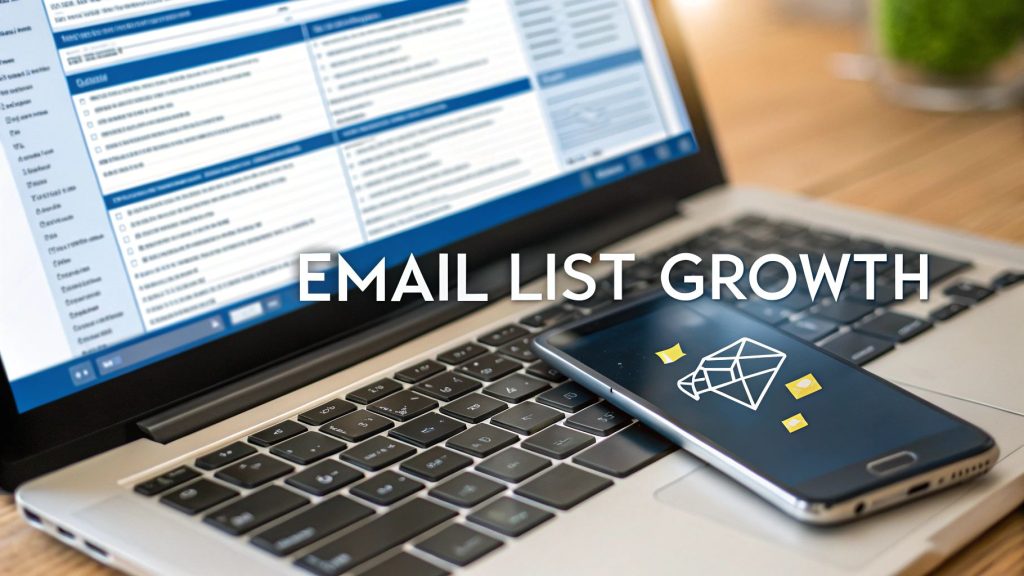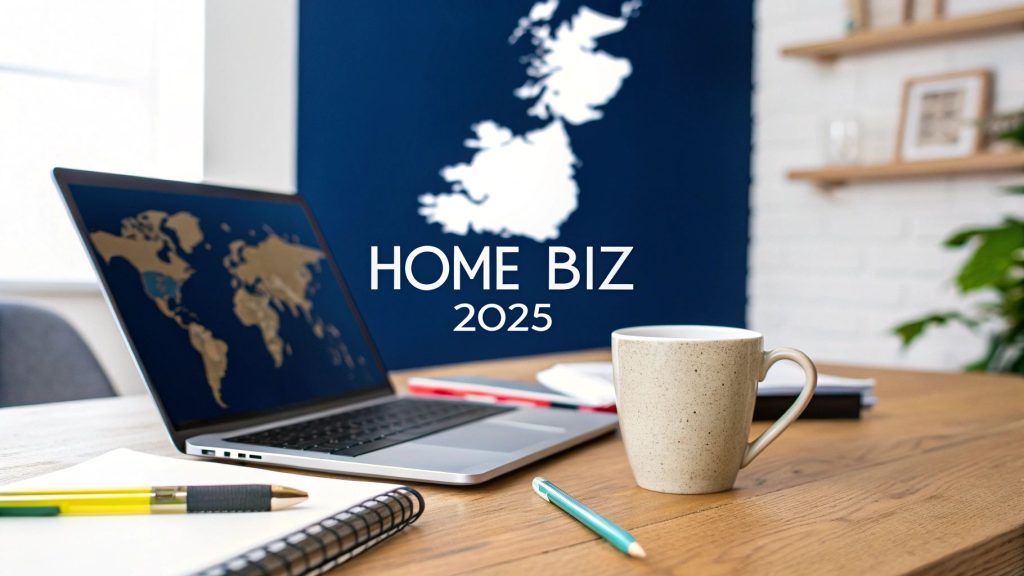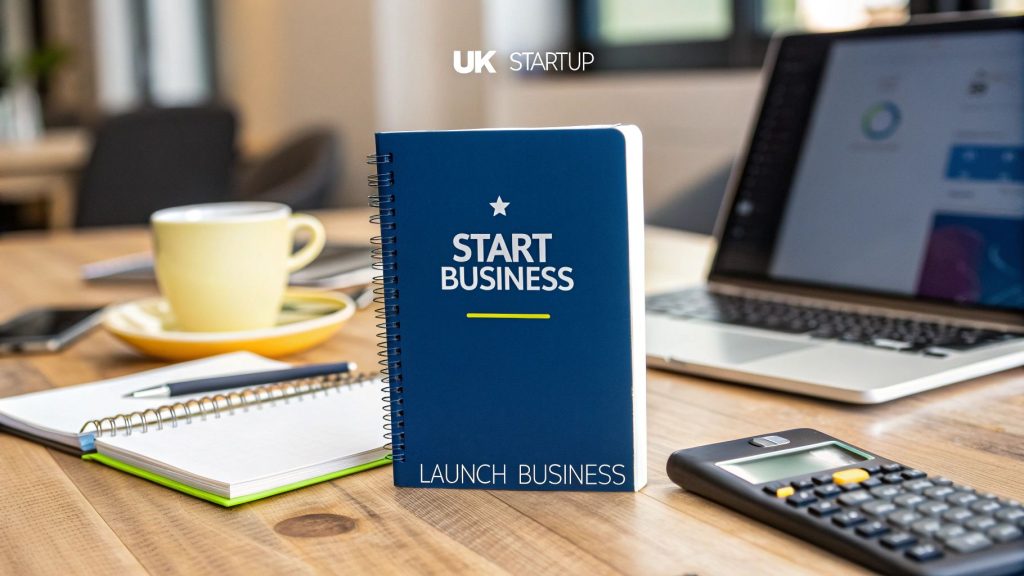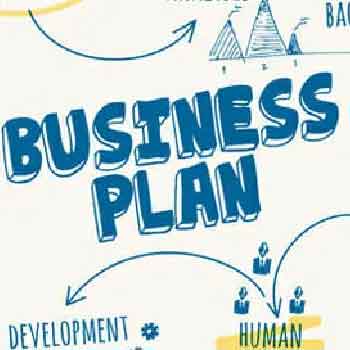10 Powerful Customer Retention Strategies
10 Powerful Customer Retention Strategies – In the relentless pursuit of growth, entrepreneurs and small business owners often fixate on a single metric: customer acquisition. While attracting new clients is vital, the true engine of sustainable, long-term success often lies hidden in plain sight: your existing customer base. The maths is compelling. Acquiring a new customer can cost anywhere from five to 25 times more than retaining a current one. Furthermore, a study by Bain & Company revealed that increasing customer retention rates by just 5% can boost profits by a staggering 25% to 95%. These figures underscore a fundamental business truth: your most valuable asset is the customer you have already won.
This article is designed as a practical playbook for entrepreneurs, startup founders, and company directors who want to move beyond transactional interactions and build lasting, profitable relationships. We will unpack ten proven customer retention strategies that are not only effective but also realistically implementable for smaller businesses. Forget vague theories and generic advice. Instead, prepare for a deep dive into actionable tactics, from leveraging predictive analytics to prevent churn to building a powerful sense of community around your brand.
Each strategy is broken down with specific implementation details, real-world examples, and the key metrics you should track to measure success. You will learn how to personalise the customer journey, create loyalty programmes that genuinely reward, and use customer feedback as a tool for co-creation. By the end of this guide, you will have a comprehensive framework to transform your approach, ensuring your next big win comes from the customers who already believe in you.
1. Personalised Customer Experience
A personalised customer experience is one of the most powerful customer retention strategies available today. It moves beyond generic, one-size-fits-all interactions to create tailored experiences that resonate with an individual’s specific needs, behaviours, and preferences. By leveraging customer data, businesses can deliver individualised product recommendations, relevant content, and customised communications that make customers feel seen and valued. For example, Netflix’s recommendation engine, which suggests shows based on viewing history, is a prime example of personalisation at scale. This strategy transforms the customer journey from a simple transaction into a meaningful relationship.
This approach is highly effective because it directly addresses the modern consumer’s expectation for relevance. When a customer receives an offer that aligns perfectly with their recent purchase history or a content recommendation based on their browsing behaviour, it demonstrates a deep understanding of their needs. This level of attention significantly enhances customer satisfaction and builds strong brand loyalty, making customers far less likely to switch to a competitor.
The Impact of Personalisation on Key Metrics
Personalisation isn’t just about making customers feel special; it delivers tangible business results. From boosting engagement to increasing conversions, the data clearly shows its value. The bar chart below visualises the significant uplift that a well-executed personalisation strategy can provide across crucial business metrics.
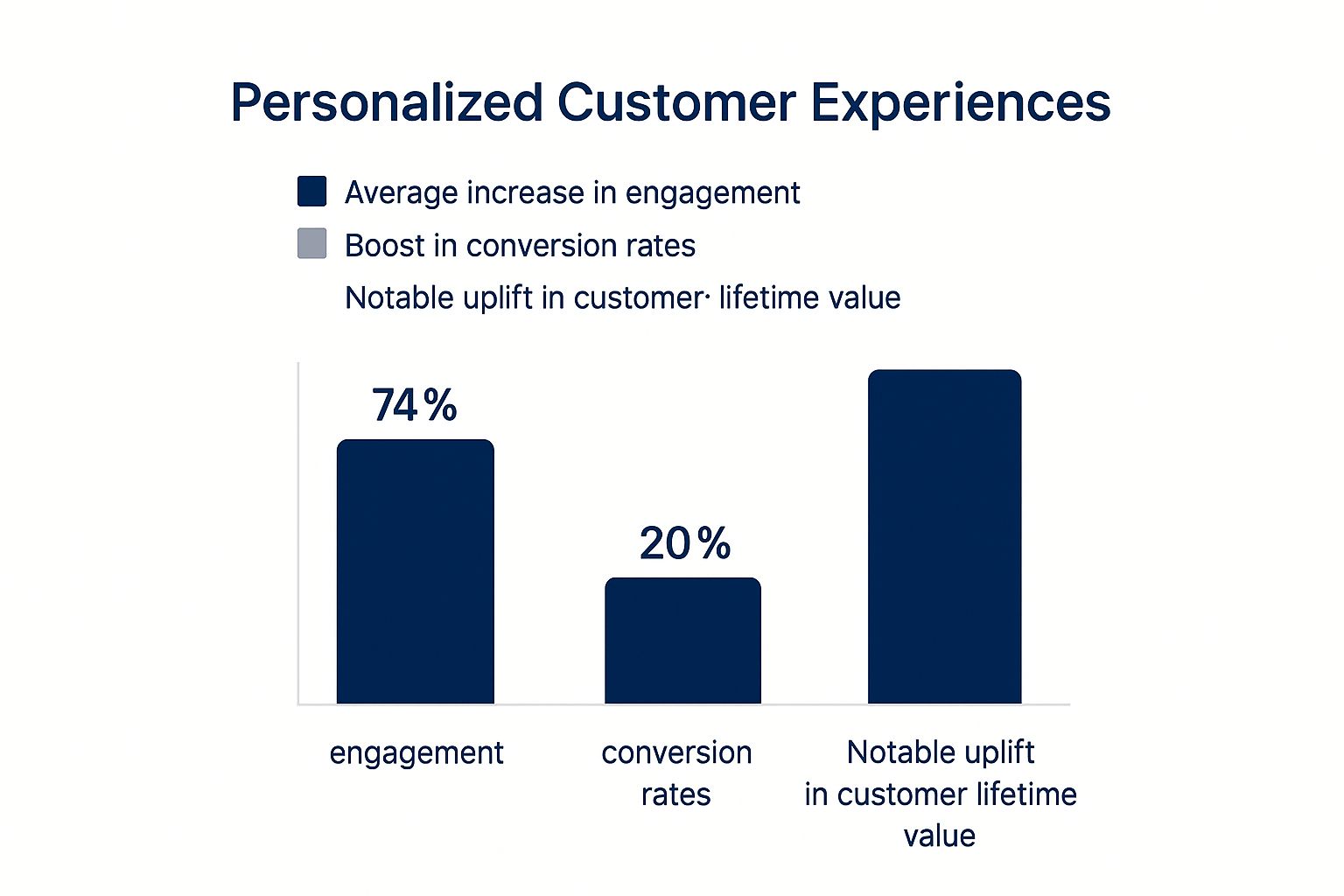
As the chart highlights, the benefits are substantial, showing a clear correlation between tailored experiences and improved business performance, including a notable increase in customer lifetime value.
How to Implement Personalisation
For small businesses, implementing this strategy can seem daunting, but it’s entirely achievable with a phased approach.
- Start with Segmentation: Begin by grouping your audience based on shared characteristics. For instance, a clothing retailer could create segments for “first-time buyers,” “customers who bought winter coats,” and “shoppers in London” to send targeted promotions.
- Leverage Zero-Party Data: Actively ask customers for their preferences. A skincare brand, for example, could offer an online quiz like “Find Your Perfect Skincare Routine” to gather data on skin type and concerns, allowing for highly personalised product recommendations.
- Use Progressive Profiling: Instead of asking for all information at once, gather it over time. After a customer’s first purchase, send a follow-up email asking for their birthday in exchange for a special discount. After their second, ask about their favourite product category.
- Balance Automation and Human Touch: Use automation to send a personalised “Happy Birthday” email with a unique discount code, but ensure a real person is available to respond if the customer replies with a specific question or comment.
2. Loyalty and Rewards Programs
A well-structured loyalty and rewards programme is one of the most effective customer retention strategies for encouraging repeat business. These programmes incentivise ongoing engagement by offering points, exclusive benefits, or tiered privileges for every purchase. They create both economic and psychological reasons for customers to stay, transforming transactional interactions into long-term, emotional connections by delivering consistent value and recognition.
This strategy is powerful because it taps into the basic human desire for reward and recognition. When customers see tangible benefits for their loyalty, such as a free coffee from Starbucks Rewards or exclusive access and free shipping from Amazon Prime, it reinforces their purchasing behaviour. This system not only fosters a sense of belonging but also builds a significant barrier against competitors, as customers are less likely to sacrifice the rewards they have accumulated.
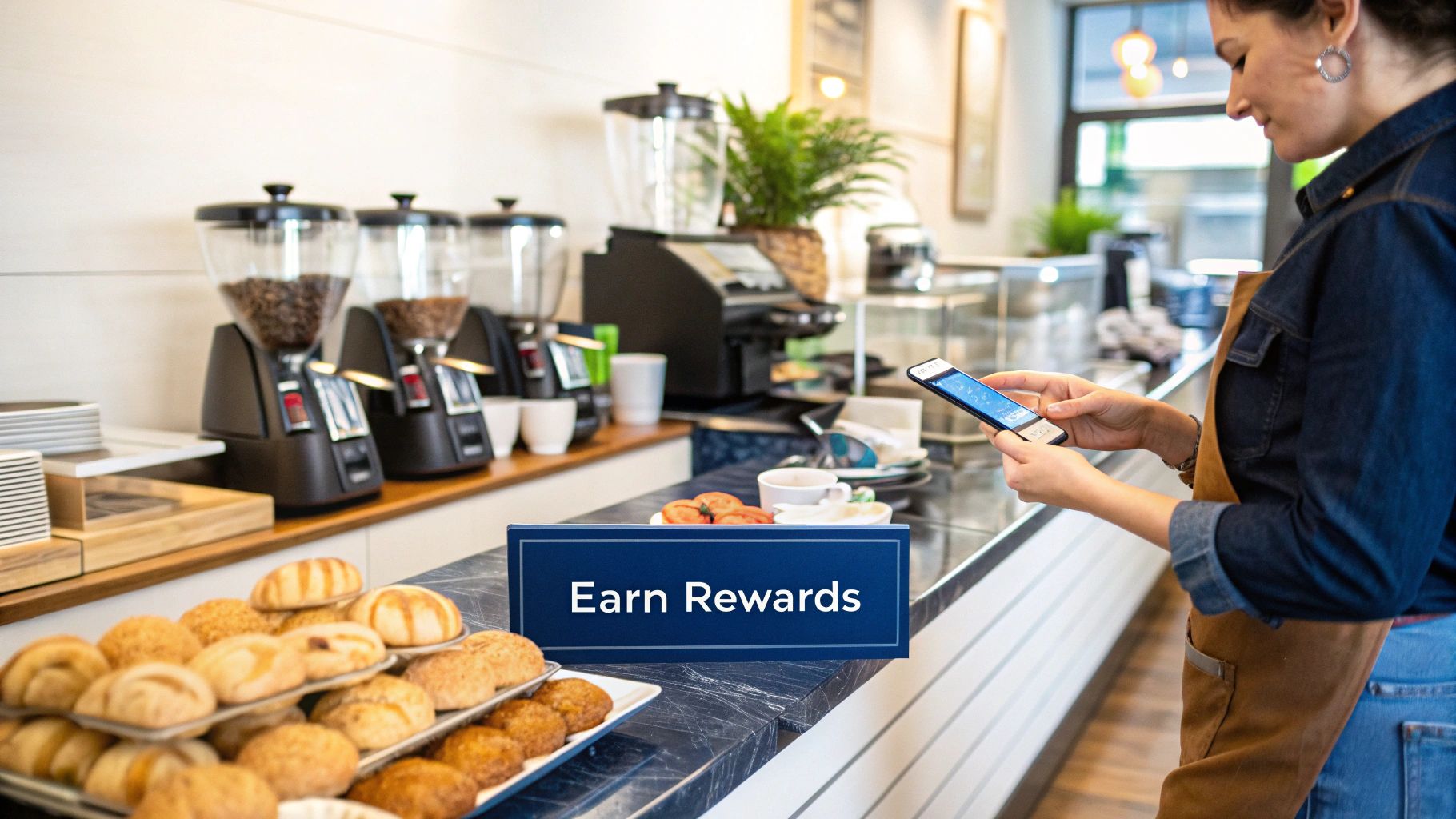
The Impact of Loyalty Programmes on Key Metrics
Loyalty programmes deliver clear, measurable business outcomes that go far beyond simple customer satisfaction. Successful programmes, like Sephora’s Beauty Insider which drives 80% of its annual sales, demonstrate a direct link between rewarding loyalty and increasing revenue. They are proven to boost purchase frequency, increase average transaction value, and significantly extend customer lifetime value by making retention a core part of the business model.
How to Implement a Loyalty Programme
For small businesses, launching a loyalty programme can be straightforward and highly impactful. The key is to design a system that is both valuable to the customer and sustainable for your business.
- Make Enrolment Effortless: Allow customers to join at the till with just their phone number. A local café could use a simple tablet-based system where customers enter their number to collect digital “stamps” towards a free drink, avoiding cumbersome physical cards.
- Ensure Rewards are Attainable: Set realistic goals. For a bookstore, offering a £5 voucher after a customer spends £50 is far more motivating than requiring them to spend £500. The reward should feel within reach.
- Communicate Value Clearly: Send a monthly email summary to members saying, “You have 85 points! You’re only 15 points away from your next reward.” This keeps the programme top-of-mind and encourages a return visit.
- Offer Experiential Rewards: A boutique clothing store could offer loyalty members an invitation to an exclusive “first look” event for the new season’s collection, complete with a glass of prosecco. This creates a memorable experience that a simple discount cannot replicate.
3. Proactive Customer Support and Success Management
Proactive customer support and success management is a forward-thinking retention strategy that shifts from a reactive to a preventative model. Instead of waiting for customers to report problems, this approach involves anticipating their needs, identifying potential issues before they escalate, and guiding them toward achieving their desired outcomes with your product or service. This involves using tools like predictive analytics, customer health scoring, and regular check-ins to ensure they continuously derive maximum value.
This method is highly effective because it fundamentally changes the customer relationship from transactional to partnership-based. For example, a software company might notice a user hasn’t activated a key feature after 30 days and proactively send them a short video tutorial on how to use it. This demonstrates a deep commitment to their success, making your business an indispensable partner and drastically reducing the likelihood of churn. It’s one of the most powerful customer retention strategies for B2B and SaaS models.
The Impact of Proactive Success Management on Key Metrics
A proactive approach delivers significant, measurable results that directly impact the bottom line. Companies that invest in customer success, like Salesforce with its 93% renewal rates and HubSpot achieving over 100% net revenue retention, prove its value. By focusing on the customer’s long-term success, businesses not only reduce churn but also create opportunities for upselling and expansion. For instance, Gainsight, a platform built around this philosophy, helps its clients reduce churn by an average of 30-40%.
This strategy transforms customer support from a cost centre into a revenue driver. By ensuring customers are successful, you create advocates who are more likely to upgrade, expand their usage, and refer new business. The focus shifts from simply solving tickets to maximising customer lifetime value.
How to Implement Proactive Support
For smaller businesses, implementing a full-scale customer success programme can be phased in effectively.
- Segment and Prioritise: An accounting software firm could offer dedicated quarterly check-in calls to its enterprise clients, while providing automated monthly usage reports and tips to its small business customers.
- Define and Track Success Metrics: For a project management tool, success might be defined as “user creates 5 projects and invites 3 team members within the first month.” Tracking this helps identify users who are not getting full value from the product.
- Create Intervention Playbooks: If a customer of an e-commerce platform experiences a sudden drop in sales, a pre-defined playbook could trigger a notification to a success manager, who can then reach out with an offer to review their marketing setup.
- Empower Your Team: A support agent should be able to offer a small service credit or a one-month free upgrade to a customer who has experienced a recurring technical issue, without needing to escalate the request through multiple layers of management.
4. Community Building and Engagement
Community building is one of the most durable customer retention strategies, focusing on creating dedicated spaces where customers connect with the brand and each other. This approach transforms one-way transactions into a network of relationships, turning customers into loyal members who feel a sense of belonging. By fostering an environment for shared experiences and peer support, businesses create powerful social bonds that add value far beyond the product itself, making customers deeply invested in the brand’s ecosystem.

This strategy is highly effective because it taps into the fundamental human need for connection. When customers become part of a tribe, like the legendary Harley Owners Group (H.O.G.), their identity becomes intertwined with the brand. This creates an emotional loyalty that is incredibly difficult for competitors to break. A well-managed community not only reduces churn but also generates valuable user content, provides peer-to-peer support, and offers direct insights into customer needs.
The Impact of Community on Key Metrics
A strong community delivers substantial business outcomes by fostering deep-rooted loyalty and engagement. For instance, Peloton’s community features are a key driver of its impressive 92% retention rate, while Sephora’s Beauty Insider Community generates five times more engagement than its social media channels. This shows a direct link between a sense of belonging and key performance indicators like customer lifetime value and brand advocacy. Integrating a community can also reduce support costs, as members often help each other solve problems.
How to Implement Community Building
Even a small business can build a thriving community by starting with a focused and intentional approach. It’s about creating a space with purpose.
- Start with a Clear Purpose: A brand selling high-end cooking equipment could create a community focused on sharing complex recipes and advanced cooking techniques, providing a clear value proposition for its members.
- Hire a Dedicated Manager: A community doesn’t run itself. A dedicated community manager is essential for nurturing discussions, enforcing guidelines, and making members feel welcome.
- Recognise and Reward Contributors: In a software user forum, the community manager could highlight a “Post of the Week” where a user shared an innovative solution, and send that user some branded merchandise as a thank you.
- Bridge Online and Offline: A local brewery could host its online community members for an exclusive in-person beer tasting event at their facility, strengthening the bonds formed online.
- Leverage Community Insights: The makers of a graphic design app could monitor their community forum to see which feature requests are most popular, using this direct feedback to prioritise their development roadmap. For those looking to formalise their social mission, understanding how to operate as a community-focused organisation can be invaluable. Explore how to run a business with community at its core.
5. Subscription and Membership Models
Transitioning from one-time transactions to recurring revenue is one of the most powerful customer retention strategies a business can adopt. Subscription and membership models reframe the customer relationship, shifting the focus from a single sale to continuous, long-term value delivery. By offering ongoing access to products, services, or exclusive benefits for a recurring fee, businesses create a built-in framework for loyalty and habit formation. This model makes customers part of an ongoing journey, not just a momentary transaction.
This approach is profoundly effective because it aligns the company’s success directly with the customer’s ongoing satisfaction. A customer who continues to pay is a customer who continues to see value. Businesses like Chewy have perfected this, with their Autoship programme accounting for over 70% of sales by offering convenience and savings on repeat purchases of pet food. This strategy inherently increases switching costs and provides predictable revenue, allowing businesses to forecast more accurately and invest in enhancing the customer experience.
The Impact of Recurring Revenue on Business Stability
A subscription model fundamentally changes a company’s financial health and its relationship with customers. Instead of chasing new sales each month, the focus shifts to nurturing and retaining the existing customer base, which is a far more sustainable growth engine. This stability allows for reinvestment into the product or service, creating a virtuous cycle of improvement and value that further strengthens retention. The result is a more resilient business with deeper, more engaged customer relationships.
How to Implement Subscription or Membership Models
For small businesses, launching a subscription offering can be a game-changer. It requires a mindset shift from acquisition to retention and a commitment to delivering consistent value.
- Offer a Clear Value Proposition: A local coffee roaster could offer a subscription for a monthly delivery of freshly roasted beans, providing both convenience and the chance to discover new blends. The value is clear: never run out of great coffee.
- Reduce Initial Friction: A language-learning app could offer a 7-day free trial of its premium subscription, allowing users to experience the full range of features before committing to a monthly payment.
- Perfect the Onboarding Process: A new subscriber to a fitness app should receive a welcome email series that guides them through setting up their profile, choosing their first workout, and joining a community challenge, ensuring they see immediate value.
- Continuously Add Value: A subscription box for snacks must do more than send the same items each month. It should introduce new brands, exclusive flavours, and seasonal specials to keep the experience exciting and prevent subscriber fatigue.
- Manage Involuntary Churn: When a subscriber’s credit card expires, an automated system should send a polite email with a direct link to update their payment details, recovering revenue that would otherwise be lost.
6. Omnichannel Experience Consistency
An omnichannel experience is a powerful customer retention strategy that ensures a seamless and integrated journey across all channels and touchpoints. This approach acknowledges that modern customers interact with a business through various platforms, from a physical store and website to a mobile app and social media. By unifying these interactions, you create a cohesive brand experience where information, service, and quality remain consistent, regardless of how or where the customer engages.
This strategy is highly effective because it removes friction and meets the high expectations of today’s consumers. For example, a customer might add an item to their online shopping cart on their laptop, later receive a reminder on their phone via the brand’s app, and then choose to “click and collect” the item from their local store. This seamless flow creates effortless convenience, building trust and reinforcing brand reliability, making them more likely to remain loyal.
Why a Unified Experience Retains Customers
Providing a consistent omnichannel experience directly impacts loyalty and lifetime value by making interactions simpler and more intuitive. Customers who can easily move between channels without repeating themselves or hitting dead ends feel understood and valued. This operational excellence translates into higher satisfaction and a stronger emotional connection to the brand. For example, a customer who uses an app to check in-store stock levels before visiting saves time and avoids frustration, a positive experience they will associate with your business.
How to Implement Omnichannel Consistency
For entrepreneurs and small businesses, creating a fully integrated omnichannel system is a gradual process that starts with a clear focus on the customer journey.
- Map the Customer Journey: A retailer could map the path of a customer returning an online order. Can they easily process it in-store? Does the store assistant have access to the original order details? This process reveals friction points that need fixing.
- Invest in Unified Data: A CRM system should ensure that when a customer calls the support line, the agent can see their entire purchase history, recent website visits, and any previous support tickets, creating a single view of the customer.
- Train Your Teams: A retail company should train its in-store staff on how the website and app work, so they can assist customers who have questions about online promotions or their digital loyalty account.
- Prioritise Mobile Optimisation: A restaurant must ensure that customers can easily view the menu, book a table, and get directions on their mobile phone, as this is often the final step before a physical visit.
7. Customer Feedback Loop and Co-Creation
A customer feedback loop is a systematic process of gathering, analysing, and acting on customer insights. This strategy goes beyond simple surveys by actively involving customers in co-creation, where their ideas directly influence product development, feature prioritisation, and business decisions. It transforms customers from passive consumers into active partners, fostering a powerful sense of ownership and investment in your brand’s success.
This approach is one of the most effective customer retention strategies because it ensures your business evolves in direct response to the people it serves. For instance, when the software company Slack added threaded conversations, it was a direct response to overwhelming customer feedback requesting a better way to organise discussions. When customers see their suggestions implemented, they feel genuinely heard and valued, making them significantly more loyal.
The Impact of Co-Creation on Loyalty
Actively involving customers in your development process delivers tangible business results by building a community around your brand. For instance, LEGO’s Ideas platform, where fans submit and vote on new set designs, has generated over a billion dollars in revenue from customer-created products. This demonstrates that listening to your audience isn’t just good for morale; it’s a powerful engine for innovation and commercial success. By making customers part of the story, you solidify their long-term commitment.
How to Implement a Feedback Loop
For small businesses, creating a system for co-creation is more accessible than ever and can start with simple, focused actions.
- Close the Loop: After a customer submits a feature request, send an automated email confirming receipt. Later, if you build it, send a personal follow-up: “Hi Jane, remember that feature you asked for? We just launched it! Here’s how to use it.”
- Use Mixed Feedback Methods: A hotel could use an NPS survey to get a general satisfaction score, but also place physical comment cards in rooms to gather specific, qualitative feedback about the guest’s stay.
- Reward Valuable Contributors: A video game developer could give “beta tester” status and in-game credits to players who consistently report bugs and provide constructive feedback on new updates. Glossier famously built its brand by incorporating community feedback into product development, treating its customers as co-founders.
- Act Visibly and Quickly: A café that receives multiple comments about needing more vegan options could introduce a new vegan sandwich the following week and announce it on social media, tagging the customers who made the suggestion.
8. Value-Based Education and Content Marketing
Value-based education is a customer retention strategy focused on empowering customers through knowledge. Instead of just selling a product, this approach involves creating and distributing valuable content that helps customers master its use, develop relevant skills, and achieve their goals. By positioning your brand as a trusted educator and thought leader, you build a relationship that extends far beyond the initial transaction, making customers feel more competent and invested in your solution.
This strategy is highly effective because it directly tackles a primary cause of customer churn: failure to achieve a desired outcome. A company selling advanced camera equipment, for example, might create a series of free online tutorials on photography techniques. When customers learn how to leverage your product to its fullest potential, their satisfaction and success rates soar. This continuous engagement with helpful content reinforces the value of your offering, creating a powerful moat against competitors.
Why Educating Customers Drives Loyalty
Empowering customers with knowledge creates a powerful cycle of success and retention. As they become more proficient, they achieve better results, which in turn deepens their loyalty and increases their lifetime value. The video below explains how creating value-driven content can transform your customer relationships.
As demonstrated, educational content shifts the focus from selling features to enabling customer success, a cornerstone of modern retention marketing.
How to Implement Value-Based Education
Even with limited resources, small businesses can effectively implement this strategy to nurture customer relationships.
- Map Content to the Customer Journey: A company selling email marketing software should have a “Getting Started” guide for new users, a webinar on “Advanced Segmentation” for experienced users, and case studies for decision-makers.
- Use Diverse Formats: A financial planning firm could offer a detailed blog post on “Retirement Planning,” a short video explaining “Compound Interest,” and a downloadable budget calculator. This approach is a key part of many low-cost marketing strategies for startups.
- Focus on Outcomes, Not Just Features: Instead of a tutorial on “How to Use Our Calendar Sync Feature,” a productivity app should create content titled “How to Save 5 Hours a Week by Automating Your Schedule.”
- Gamify the Learning Experience: A coding platform can offer certificates for completing different programming language courses. This provides a sense of achievement and a tangible credential that users can add to their professional profiles, as demonstrated by HubSpot Academy’s free certifications.
9. Predictive Analytics and AI-Driven Churn Prevention
Leveraging predictive analytics is one of the most proactive customer retention strategies a business can employ. This data-driven approach uses artificial intelligence (AI) and machine learning to analyse customer behaviour, usage patterns, and engagement data to forecast which customers are at risk of churning. By identifying these individuals before they decide to leave, businesses can launch targeted, personalised interventions designed to resolve issues and re-engage them, effectively preventing customer loss.
This strategy is powerful because it shifts retention efforts from reactive to proactive. Instead of waiting for a cancellation notice, you can spot early warning signs like a drop in product usage, an increase in support tickets, or a decline in engagement. For example, Vodafone successfully reduced churn by using predictive models to identify at-risk customers and offer them personalised retention incentives like a discounted plan or a free data upgrade. This foresight allows you to address underlying dissatisfaction and reinforce value before a competitor has a chance to step in.
The Impact of Predictive Analytics on Key Metrics
Predictive analytics provides a clear, data-backed roadmap for retention, allowing businesses to allocate resources efficiently by focusing on customers who need the most attention. This targeted approach not only prevents revenue loss from churn but also boosts overall customer satisfaction and loyalty by demonstrating that you understand and care about their experience. The ability to intervene at the right moment with the right offer is transformative for customer lifetime value.
For instance, SaaS platforms like Gainsight and Totango are built around this principle, helping companies monitor customer health scores in real-time. By predicting churn risk, these tools enable customer success teams to take precise actions that protect and grow their customer base, proving the direct link between predictive insights and improved financial performance.
How to Implement Predictive Analytics
For smaller businesses, implementing AI-driven analytics may seem complex, but it can be approached systematically.
- Define Churn and Identify Indicators: For a subscription box service, churn is a cancellation. Leading indicators might include a customer skipping two consecutive boxes, removing items from their next order, or a sudden stop in opening marketing emails.
- Centralise Your Customer Data: Use a CRM to combine a customer’s purchase history, website activity (like pages visited), and support ticket history into one profile. This gives a holistic view needed for accurate predictions.
- Segment by Churn Risk: A model might flag a user of a music streaming service as “high risk” if their listening time has dropped by 75% in the last month. This triggers a specific retention campaign for that segment.
- Test and Refine Interventions: For high-risk customers, a personal phone call from a success manager might be the most effective intervention. For medium-risk customers, an automated email offering a 20% discount on their next renewal might suffice. A/B test these offers to see what works best.
10. Emotional Branding and Storytelling
Emotional branding and storytelling is a sophisticated customer retention strategy that focuses on building a deep, meaningful connection with customers. It transcends transactional relationships by creating compelling narratives around shared values, a purpose-driven mission, and authentic brand identity. Instead of competing solely on price or features, this approach fosters loyalty based on emotional resonance, making the brand an integral part of the customer’s self-concept and belief system.
This strategy is particularly powerful because humans are wired for stories and emotional connection. When a customer feels that a brand reflects their own aspirations and values, they become more than just a consumer; they become an advocate. Brands like Patagonia have mastered this by weaving their environmental activism into their core narrative, creating fierce loyalty among customers who share those values. This emotional investment makes customers significantly less likely to be swayed by competitors.
The Impact of Brand Story on Loyalty
A strong brand narrative doesn’t just attract customers; it creates a community and drives long-term retention. It gives customers a reason to believe in the brand beyond its products. The chart below illustrates how a powerful, emotionally resonant brand story can influence key retention metrics, showing a clear uplift in customer loyalty and repeat purchase rates.
As the data shows, customers who feel an emotional connection to a brand are not only more loyal but also more forgiving of occasional missteps, providing a stable foundation for business growth. You can explore more about how this integrates with broader campaigns by reading about proven marketing strategies for small businesses.
How to Implement Emotional Branding
For entrepreneurs and small businesses, building an emotional connection can be a major competitive advantage. Here’s how to start:
- Define Your “Why”: A coffee shop’s “why” isn’t just to sell coffee. It might be “to create a welcoming space where our community can connect.” This purpose informs everything from the shop’s layout to its social media posts.
- Use Customer Stories: A company selling hiking gear could feature a blog post with photos and a story from a customer who used their equipment to climb a challenging mountain. This is more powerful than simply listing product features.
- Demonstrate Your Values: If a pet food brand values animal welfare, it should showcase its partnerships with local animal shelters and donate a portion of its profits, making the value tangible to customers.
- Be Consistent and Authentic: If a brand markets itself as sustainable and eco-friendly, its packaging must be recyclable, and its customer service responses should reflect this ethos. Any inconsistency will erode trust.
Customer Retention Strategies Comparison Table
| Retention Strategy | Implementation Complexity 🔄 | Resource Requirements ⚡ | Expected Outcomes 📊 | Ideal Use Cases 💡 | Key Advantages ⭐ |
|---|---|---|---|---|---|
| Personalised Customer Experience | High: Requires advanced data infrastructure and continuous updates | High: Data, AI/ML tools, skilled analysts | ↑ Engagement by 74%, ↑ Conversion by 20%, ↑ CLV | Companies with rich customer data and AI capabilities | Highly tailored experiences, reduced marketing waste |
| Loyalty and Rewards Programmes | Medium–High: Operationally complex with admin overhead | Medium–High: Platform, rewards budget, management | ↑ Purchase freq. by 27%, ↑ Spend by 12–18% | Retail, e-commerce, subscription businesses | Drives repeat purchases, emotional brand attachment |
| Proactive Customer Support & Success | High: Needs dedicated staff and monitoring systems | High: Personnel, tech for health scoring and automation | ↓ Churn up to 67%, ↑ Upsell by 30%, ↑ CLV | B2B SaaS, high-touch customer models | Strong relationships, early churn detection |
| Community Building and Engagement | Medium–High: Ongoing moderation and content seeding | Medium: Community managers, platform costs | ↑ Retention by 27%, ↓ Support costs | Brands aiming to increase loyalty through social bonds | Emotional attachment, peer support, advocacy |
| Subscription and Membership Models | Medium–High: Billing and delivery systems, churn management | Medium–High: Tech infrastructure, content/product refresh | Predictable revenue, ↑ LTV (5–8×), natural upsell | Recurring revenue businesses like SaaS, media, F&B | Recurring revenue, habit formation, upsell paths |
| Omnichannel Experience Consistency | Very High: Integration across multiple legacy and modern channels | High: Unified data platform, cross-team coordination | ↑ Retention by 89%, ↑ Spend by 34%, ↑ Satisfaction | Retail, financial services, multi-channel businesses | Seamless experience, higher brand trust |
| Customer Feedback Loop & Co-Creation | Medium: Feedback collection + transparent action | Medium: Tools for feedback, dedicated roles | ↑ Retention up to 55%, ↓ product risks, ↑ advocacy | Product-focused companies valuing customer input | Emotional investment, improved product–market fit |
| Value-Based Education & Content Marketing | Medium–High: Significant content development and updates | Medium–High: Content creators, platforms | ↑ Adoption, ↓ Support costs, ↑ engagement | Complex products/services requiring education | Positions brand as authority, builds long-term trust |
| Predictive Analytics & AI Churn Prevention | High: Requires quality data, advanced ML models | High: Data scientists, infrastructure, integration | ↓ Churn by 15–30%, targeted intervention, measurable ROI | Data-savvy companies with churn concerns | Proactive retention, scalable insights |
| Emotional Branding and Storytelling | Medium: Requires consistent and authentic brand messaging | Medium: Creative talent, marketing investment | ↑ Loyalty, ↑ Customer lifetime value by 306%, advocacy | Brands competing on differentiation and values | Deep emotional connection, premium pricing potential |
Start Building Your Retention Engine Today
The journey through these ten powerful customer retention strategies reveals a fundamental truth: keeping customers is not a passive activity. It’s an active, dynamic, and deliberate process of building relationships and consistently delivering value. We’ve explored a wide array of tactics, from the intricate data-driven world of predictive analytics to the heartfelt connection forged through emotional branding and storytelling. The common thread weaving them all together is a profound shift in perspective, moving from a transaction-focused mindset to a relationship-centric one.
Improving your retention rate isn’t about deploying a single, isolated tactic. True success lies in creating a cohesive ecosystem where multiple strategies work in harmony. Imagine a customer who is part of your tiered loyalty programme (Strategy #2), receives proactive check-ins from your support team (Strategy #3), and actively participates in your online community (Strategy #4). This multi-layered experience creates powerful, interwoven bonds that are far more resilient than a simple discount or a one-off positive interaction. It transforms a customer from a mere purchaser into a genuine advocate and a valued member of your brand’s world.
Your First Steps to Lowering Churn
The sheer number of options can feel overwhelming, but the key is to start with focused, intentional action. Don’t attempt to implement all ten strategies at once. Instead, critically assess your business, your resources, and most importantly, your customer base.
- For a B2B SaaS company: You might prioritise building a robust customer feedback loop (Strategy #7) and investing in proactive success management (Strategy #3). Your first step could be to implement a simple Net Promoter Score (NPS) survey and schedule quarterly business reviews with your top clients.
- For an e-commerce brand selling niche hobby supplies: Your initial focus could be on community building (Strategy #4) and value-based content marketing (Strategy #8). You could start a dedicated Facebook group for enthusiasts and create a series of “how-to” video tutorials showcasing your products in action.
- For a local service-based business like a salon or café: Implementing a simple but effective loyalty programme (Strategy #2) and mastering the personalised customer experience (Strategy #1) would be the most impactful starting points. This could be as straightforward as a digital stamp card and training staff to remember the names and preferences of regular patrons.
The goal is to choose one or two of these customer retention strategies that align most naturally with your business model and offer the quickest path to a measurable impact. Start small, define what success looks like, measure your results meticulously, and then iterate.
The Lasting Value of Customer Loyalty
Mastering customer retention is one of the most economically sound investments you can make in your business. It is the engine of sustainable growth, creating predictable revenue streams that insulate you from the volatility of constantly chasing new leads. Loyal customers spend more, more often, and are less sensitive to price changes. They become your most credible marketing channel, sharing their positive experiences with their networks and generating powerful word-of-mouth referrals at no cost to you.
Ultimately, building Powerful Customer Retention Strategies is about more than just numbers on a spreadsheet; it’s about building a legacy. It’s about creating a business that people genuinely love and want to support, a brand that becomes an integral part of their lives. By focusing on the customers you already have, you are not just plugging a leaky bucket; you are laying the foundation for a more resilient, profitable, and meaningful enterprise for years to come.
Ready to turn these Powerful Customer Retention Strategies into a structured, actionable growth plan for your business? The team at Grow My Acorn specialises in helping entrepreneurs and small businesses build the systems and strategies needed for sustainable growth, including robust customer retention frameworks. Visit Grow My Acorn to learn how we can help you build an engine for lasting customer loyalty.


